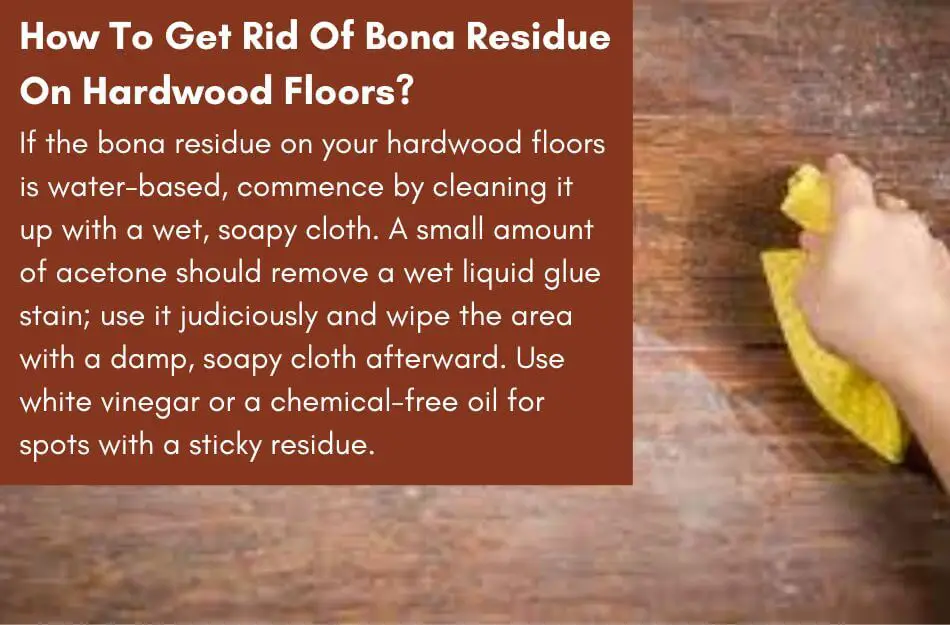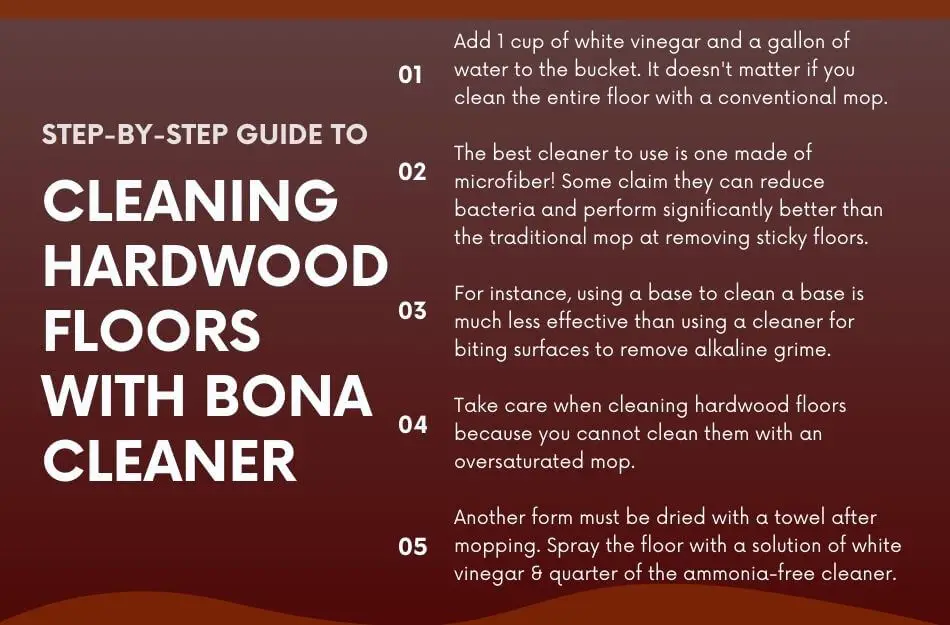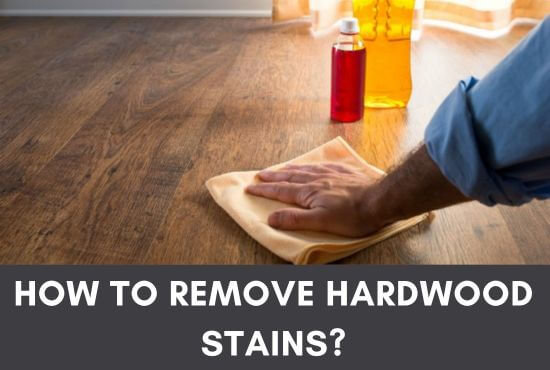If the bona residue on your hardwood floors is water-based, commence by cleaning it up with a wet, soapy cloth.
A small amount of acetone should remove a wet liquid glue stain; use it judiciously and wipe the area with a damp, soapy cloth afterward. Use white vinegar or a chemical-free oil for spots with a sticky residue.
Use a soft toothbrush to rub it into the discoloration carefully, then wait a moment before wiping it away.
If someone places a sticker or adhesive tape on your wood floor, these techniques may still be effective.

Let’s go over how to remove the bona residue step by step:
Table of Contents
- 1 How To Get Rid Of Bona Residue On Hardwood Floors? | Step-by-Step Guide
- 2 Does Bona Leave A Residue on Wood Floors?
- 3 How Do You Remove White Haze from Hardwood Floors?
- 4 Why is My Floor Sticky After Using Bona?
- 5 How To Remove The Sticky Residue From Hardwood Floors?
- 6 How Long Does Bona Hardwood Floor Cleaner Last?
- 7 What Consistency of Bona Cleaner Is Best to Avoid Residue?
- 8 How Frequently Should Bona Hardwood Floor Cleanser Be Used?
- 9 How Do You Get Rid of Bona Buildup?
- 10 What Are The Different Methods Of Cleaning Hardwood Floors With Bona Cleaner?
- 11 Final Thoughts
How To Get Rid Of Bona Residue On Hardwood Floors? | Step-by-Step Guide

- Add 1 cup of white vinegar and a gallon of water to the bucket. It doesn’t matter if you clean the entire floor with a conventional mop.
- The best cleaner to use is one made of microfiber! Some claim they can reduce bacteria and perform significantly better than the traditional mop at removing sticky floors. You can eliminate the sticky residue using a surface cleaner opposing pH to the tough dirt.
- For instance, using a base to clean a base is much less effective than using a cleaner for biting surfaces to remove alkaline grime. Sadly, you can’t employ similar pH levels because doing so produces the things you’re attempting to avoid sticky floors.
- Take care when cleaning hardwood floors because you cannot clean them with an oversaturated mop.
- Another form must be dried rapidly with a clean towel after mopping. We advise twisting your mop sufficiently until it feels like a damp towel. After mopping, if the surfaces are still sticky, spray them with a solution of white vinegar or water and a quarter of the ammonia-free cleaner.
Some sites claim that heating a dried glue residue will loosen enough to be scraped off with a blunt edge.
These are additional methods for getting rid of adhesive residue from hardwood floors. Another method is dabbing a little petroleum jelly onto the stain.
If you are confused about which bona cleaner to choose, I have written an article on the Difference Between Bona and Professional Bona so that you can get the right one as per your hardwood flooring needs.
Does Bona Leave A Residue on Wood Floors?
Bona can occasionally leave a residue on wood surfaces. The beauty and luster of wood floors are meant to highlight your living space’s best features.
It can be challenging to restore surfaces with a residue that has become dull or cloudy. It’s feasible, but with the right information, your attempts to restore the appearance of your wood floors could improve things.
How Do You Remove White Haze from Hardwood Floors?
The cleaner buildup is the most frequent cause of cloudy-looking wooden floors. The hazy layer can be eliminated using a few various techniques.

Sand and Refinish
The most aggressive strategy is to sand the floor, remove the current finish, and apply a new finish. It isn’t the greatest option if you have reinforced hardwood floors.
Manufactured floors can usually only be cleaned and refinished a few times before the planks become damaged.
Using this technique as a last option is generally not preferred because it can be pricey, time-consuming, and messy regardless of your wood or engineered hardwood.
Don’t Miss: Best Bona Cleaner For Hardwood Floors | Top 03 Picks
Ammonia Solution
Although sticky surfaces are annoying, you can remove the debris causing them in various ways. You can start by using an ammonia-free cleaner.
Spray a two-foot portion of your floor, then wait about two minutes for the cleaner to dry. Next, scour the floor area where you applied the cleaner with a dish-scrubbing sponge.
Immediately wipe the area with a clean, damp cloth after scrubbing to prevent the residue from drying on the hardwood floor.
Repeat this procedure to remove the remaining bona residue from your hardwood floor.
Why is My Floor Sticky After Using Bona?
Some cleaning products are effective on tiles but leave sticky surfaces and may degrade the quality of any hardwood floors.
Utilizing an Abundant Quantity of Cleaning Agents
It is a misconception that more cleaning agents will make your laminate or wood surfaces cleaner. The reverse outcome will occur if you use too much cleaning solution.
You must always be precise when following the cleaning solution labels’ instructions to remove sticky surfaces.
You could see soapy residue when you believe you have applied more than is necessary.
Because most cleaning products come with measuring cups, you can always use the suggested dosage, so you don’t need to worry too much.
Dilute Concentrated Cleaners
While purchasing concentrated cleaning supplies rather than ready-to-use bottles is more cost-effective, you must correctly dilute the concentrated cleaner in the bucket.
It will be simpler to clean your floors if you use a strong cleaning solution without diluting them with enough water.
Rather, it will only cause significant leftover problems. Follow the instructions and reduce your powerful cleansers as directed.
Using Dirty Water
Using dusty water in the same container as clean water, particularly if you have hardwood or tile flooring, is another cause of sticky floors.
The best solution is to switch the filthy water into clean water when you notice floating debris or when they all end up at the bottom of the cleaning container.
By doing this, you will not carry the dirt from the water’s surface. The same damaging loop will occur if you repeatedly let the mop soak in the same water.
To avoid wasting your cleaning time, eliminate the dirty water individually as you clean the floors.
When you’re done scrubbing the floor, flush everything with fresh water. You can tell when water is clean or dirty, so always refill it to eliminate any sticky residue.
Use steam wipes or microfiber mops because they absorb grime better if it is difficult.
They can keep the dirt for an extended time without dumping it into the water.
The kind that instantly distinguishes between pure and dirty water is another option. If you decide to buy this mop, it will enable you to clean it more quickly.
How To Remove The Sticky Residue From Hardwood Floors?
Both sticky tag residue and glue residue can come from the projects you use, and both are difficult to get rid of.
The essential thing is to be gentle when attempting to remove the sticky substance because you need to protect the surface.
We’ve described removing the sticky material without harming the Hardwood floor. You’ll need the following to get the adhesive and sticky residue off the wood:
Step 1
Utilize the oil, vinegar, and varnishes in a small area before cleaning to see if the wood responds incorrectly. Maintaining a clean, dry floor will help you identify the sticky region.
Step 2
Start by using veggie oil. Rub the residue with some veggie oil. Then submerge it for two to three hours. Use the hairdryer to dry the debris with warm air.
It will greatly loosen the sediment. Wipe the region with warm water and a dry cotton cloth. The gummy residue will disappear.
Step 3
You can then use the furniture polish to remove the adhesive residue. You must apply the polish to the region with a cotton cloth. You should apply the polish more than once to achieve improved results.
Step 4
You can use nail paint remover to remove the wood’s stickiness. Apply the nail polish eraser to the region with a cotton ball.
Ensure you are distributing in the region where the residue is by rubbing the region in a circular motion.
After letting it sit for a while, use a cotton cloth to clean the region. Next, using a damp cloth, remove any remaining nail paint remover from the area.
Step 5
You can attempt to use mineral oil to get rid of the adhesive buildup. After applying the oil, rub the region with a cloth. Wipe the dirt off the surface after some time has passed.
Step 6
This stage is for persistently sticky, hard messes on the floor. It would be best if you used denatured alcohol to get clear of them. However, you can use a few because they risk damaging the surface.
To eliminate the sticky residue from the floor without causing any damage to the surface, test the one that only works.
Apply alcohol to the area, and then use a towel to wipe it down. It works as an enchantment.
Step 7
The adhesive material can be removed using a steam mop. All you have to do is mop the surface with a solution made of warm water and vinegar.
You can learn How To Clean And Disinfect Hardwood Floors With Vinegar? in detail with the 3-in-1 ingredient solution.
When using the mop, you must apply weight. Clean the surface with a mop until the gummy buildup is gone.
Step 8
On the market are professional sticky removal tools. You can use natural ingredients to avoid dealing with the inconvenience. Please make certain that it is wood-safe only.
How Long Does Bona Hardwood Floor Cleaner Last?
The Bona refresher doesn’t require that it be peeled with a stripping agent to be removed; it fades off over time and with repetitive damp mopping.

Depending on the traffic volume, it lasts for between two and four months before being redone to maintain a high shine. But the cleanser is a blend of acrylic and polyurethane.
It is more challenging to eliminate due to the acrylic component. Instead of sanding down to bare wood, the refresher can erase with repetitive washing or fade off in a few months.
Since the Bona cleaner never wears off fully, it must be completely stripped off to be removed.
You May Also Find Helpful: How To Clean And Deodorize Hardwood Floors? The Easy Guide
What Consistency of Bona Cleaner Is Best to Avoid Residue?
The ratio of bona hardwood cleaners will be 2: 1 depending on the floors needed.
Combine the 4-ounce pure Bona cleanser with twenty-eight ounces of water to fill a standard 32-ounce spray bottle with the appropriate cleaning solution.
To remove debris or loose dirt, vacuum, sweep, or dust mop the surface.
One component concentrates on two parts of water, making up the 2:1 mixture ratio of the Bona Hardwood Floor Cleaner. The water concentrate blend ratio in the Bona Cleaner is 7:1.
How Frequently Should Bona Hardwood Floor Cleanser Be Used?
You should clean your hardwood floors periodically for two to four months to add shine and protection, depending on how much foot traffic is in your home.
How Do You Get Rid of Bona Buildup?
The good news is that you can quickly eliminate the Bona Hardwood Polish buildup using the Extreme Floor Polish and Wax Stripper.
Using Bona’s floor polish remover is possible, but we don’t suggest it because removing the shine from your floors takes a lot of time and effort.
What Are The Different Methods Of Cleaning Hardwood Floors With Bona Cleaner?
Vacuum or Scrub Every Day
Although it may seem straightforward, selecting the appropriate tools is the secret to keeping your wood floors clean and gorgeous.
To avoid scratches, sweeping with a soft-bristled broom and using a cleaner with soft-bristle rollers is best. If feasible, try to buy a vacuum with an extendable beater bar.
Use Bona products designed for wooden floors to sweep or vacuum every day.
Clean Up Spills Right Away
It would be best if you cleaned up spills immediately to preserve the quality of your parquet floor.
Inconvenient water bands that are challenging to remove can result from spills left unattended for too long.
Likewise, if stagnant water is left unattended for too long, it may eat through the finish.
Mud and dark
Foods can also leave marks behind. Apply a hand towel or cloth to a spill to clear it up effectively.
Next, rinse the floor with a mop or rag that has been mildly dampened. Wipe the damp cloth in the path of the hardwood to avoid streaking.
Dust Mop
Although some may find this tedious, routine dust mopping will prevent your wooden floors from acquiring too much grime and dirt.
Dealing with any surface cleaner on hardwood surfaces, always proceed with the grain. You can keep your wooden floors spotless and well-maintained by dust-mopping them daily.
Monthly Damp Mop
Weekly wooden floor polishing can be accomplished using a Bona cloth damp mop and residue-free floor cleaner.
Damp mops are more efficient than dust mops and can remove leftover filth and grime.
Never use a conventional mop because doing so might cause your timber to diminish and buckle.
Instead, clean your wooden floors with a Bona spray tool or a Bona mop with a reusable spray canister.
Final Thoughts
Despite the cost, many homes prefer to install wood floors because of their durability and longevity.
However, you must use cleaning fluid to remove dirt when the floor becomes filthy due to food stains or dirt from shoes.
Identify the cause of the sticky residue on your surface first, then work on prevention.
Follow the instructions in this piece to eliminate bona residue from hardwood floors if the sticky adhesive goes on your floor. Make your surface fresh and clean by following the instructions.

As a co-creator of FlooringFlow.com, Emma Sophia comes on board to answer all your questions related to any flooring problems. Together with John Henry, she’s gained extensive experience in fixing many flooring problems in their own house as well as in friends and family’s. Now, she wants to share her knowledge that she gained during floor remodeling, restoring, and DIY projects.







